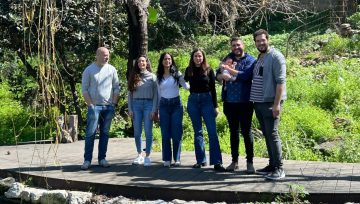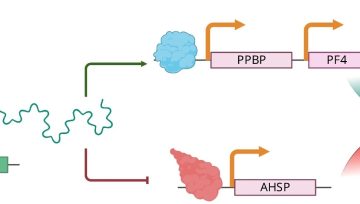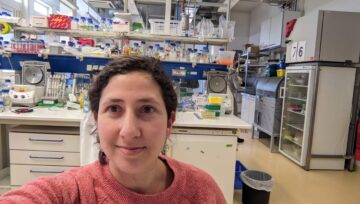On the occasion of the win, we asked him to provide us with some interesting details about the study, the path that led to the research, and a bit about him.
Hi, could you introduce yourself in a few words?
I made Aliyah from South Africa in 2018, started as a master’s student in Assaf’s lab in early 2020, and moved to a PhD at the end of 2021. I’ve been married for 3 years and have a beautiful baby daughter at home.
Could you explain what Prof. Bester Laboratory is all about?
For many years, protein-coding genes, which make up only 2% of the human genome, have been the major focus of research in the field of genetics. However, the remaining 98% of the genome, called “non-coding DNA”, contains a treasure trove of information essential to understanding complex biological processes and developing treatments for serious diseases.
In our lab, we focus on studying a fascinating group of non-coding genes called lncRNAs (long non-coding RNAs). lncRNAs are a large group of RNA molecules, similar in many ways to protein-coding genes, but they are not translated into proteins. Despite the existence of thousands of lncRNAs in the human genome, the function of most of them is still unknown.
We use advanced genetic engineering techniques, and in particular CRISPR-Cas9 technology, in order to investigate the role of these lncRNAs in cell growth and diseases. These studies may open a window to a new world of biology, and lead to the development of innovative treatments for a wide variety of diseases.
Could you tell us about your current article/research what was the main purpose of the research and what did you discover?
In this fascinating study, we developed an innovative tool called INFLAMER for predicting special RNA molecules called lncRNAs (long non-coding RNAs). lncRNAs are important “regulatory” molecules within the cell, but how they work is still not fully understood. INFLAMeR allows us to predict which lncRNAs function in different biological processes, such as cell growth and drug resistance.
We used INFLAMER to screen 39 unknown lncRNAs in a leukemia cell line. We found that 85% of them significantly affect cell growth or drug resistance, highlighting the power of INFLAMeR.
Next, we focused on one lncRNA called SNHG6. We discovered that SNHG6 affects the development of white and red blood cells and may also affect the growth of cancerous tumors. These findings point to SNHG6 as a novel therapeutic target for cancer and other diseases.
In conclusion:
- We developed a new tool for predicting lncRNAs with therapeutic potential.
- We discovered a new lncRNA called SNHG6 that may influence the growth of cancer tumors.
- This research opens a window to a new world of treatments for cancer and other diseases.
- Can you elaborate on the importance of the discovery? How will it serve you and what directions does it take? What is the application of the discovery (domains, solutions)?
Our INFLAMeR algorithm provides an important tool for discovering new lncRNAs that may play an important role in cancer and many other diseases. Targeted analyses using INFLAMeR have the potential to identify new targets and understand the pathways governing cancer more fully in order to provide better and more targeted treatments.
Name 3 prominent tools that you received in the laboratory during your work and studies?Building a laboratory from the ground up:
I started working in a completely new laboratory, which allowed me to experience a unique process of establishing a laboratory from scratch. I was privileged to be a part of establishing new protocols and systems, while learning in depth about the basic processes required for the success of scientific research.
Learning from mistakes:
Mistakes are an integral part of the research process. I have found that mistakes often lead to breakthrough results, because they make us rethink, try new approaches, and discover things we hadn’t thought of before.
Focusing on the big picture:
It’s easy to get stuck in the small details and forget the major aims of the research. I learned to step back from time to time, evaluate our progress, and recognize how each small step contributes to the achievement of the final goal.
When you are not “doing” science, what do you do?
Being a new father takes up a lot of my time, but when I can I like to cook, read fantasy novels, and squeeze in the occasional hike.
What are your plans for the future of your career?
After I finish my PhD, I plan on moving to industry (I know, I’m a sellout, I’m sorry!).
➡ A link to the full article: https://jbiomedsci.biomedcentral.com/articles/10.1186/s12929-024-01015-8
➡ A link to the Bester lab site: https://besterlab.net.technion.ac.il/
➡ To Assistant Prof. Assaf Bester page: https://biology.technion.ac.il/en/member/bester/












